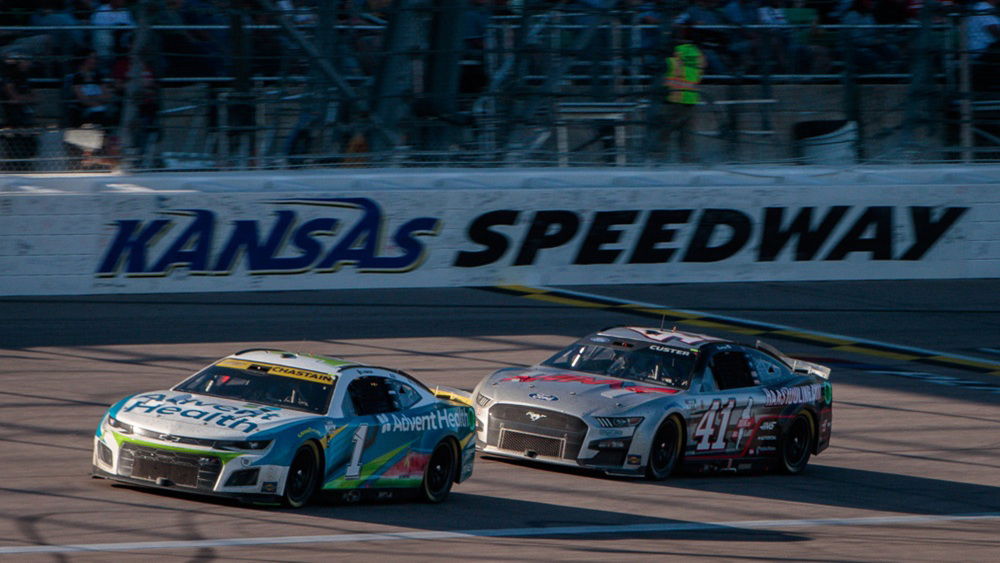

NASCAR races have long thrilled fans with high-speed action. But on the other hand, the caution periods, which were introduced to ensure safety after crashes and their debris, often break the momentum of the race that fans enjoy. In 2017, stage cautions were also added, which were planned breaks to award points and bunch the field, aiming to keep viewers hooked. But the problem is, these yellow flags often stretch out for longer durations to fill airtime with ads that test the patience of even the die-hard fans.
Watch What’s Trending Now!
That shift promised tighter racing, but it has sparked growing complaints over endless interruptions that break the excitement. Broadcasters lean on these breaks for revenue generation. As the 2025 season wraps up, some fresh data and stats are now fueling fans’ anger over these breaks and cautions, leaving broadcasters in the hot seat.
New analysis from data wiz Daniel Céspedes hit like a wrecking ball: “1/3 of Cup Series racing is just cautions. The 2025 season saw ~117 hours of racing, but nearly 40 hours (33.9%) of that was spent running under caution.” These aren’t random stats. Stage cautions often run 7-8 laps long, way beyond the 4-5 lap limit for typical incidents.
ADVERTISEMENT
Back then, NASCAR wanted more restarts and close finishes, but the result? Interrupted flows, where green-flag laps drop to 63% in some events, like Martinsville Trucks this year. It exposes how these breaks benefit broadcasters, with networks going for 43 minutes of ads per race, as seen in the 2025 Pennzoil 400 event. These show broadcasters’ ‘revenue over rhythm’ mindset, leaving fans feeling shortchanged on actual speed.
Daniel Céspedes (@_DanielCespedes)
on X: “1/3 of Cup Series racing is just cautions.” (via u/dcwright07) https://t.co/ZR9GBWfR8f https://t.co/HBuzldR9rc #NASCAR
ADVERTISEMENT
— r/NASCAR on Reddit (@NASCARonReddit) November 20, 2025
The frustration boils over at broadcasters, who extend these yellow cautions for guaranteed commercial slots, interrupting races with ad marathons. Even Kevin Harvick, fresh off retirement, called out the inconsistency: “Whatever it is, it needs to be consistent.” He said this after the 2025 Daytona 500, where no caution flew on the final lap despite a multi-car incident.
ADVERTISEMENT
Harvick, a four-time champ who raced through the old era’s fewer yellows, advocated for steady rules to avoid ‘not required’ yellow flags that manipulate outcomes by dramatically changing the race’s outcome and strategy. This data supports his point: 33.9% caution time in 2025 edges up from 30.8% in 2023, which proves the system’s flaws and why fans see networks as enablers of the slowdown.
With numbers this glaring, the garage and grandstands are erupting. Fans aren’t holding back, sharing stories that cut to the heart of the mess.
ADVERTISEMENT
Fan fury hits the track
One supporter nailed the fix upfront: “They can start with dumping stage cautions. I hate when an actual caution hits and they restart for a few laps just to throw another.”
Picture the 2025 Chicago Street Course, where Cody Ware‘s brutal brake failure wreck waited 35 seconds for a yellow caution, and because of that, many drivers didn’t slow down, which risked the field.
This idea of dropping stages was once tested briefly on road courses in 2023 without yellows, keeping green flags for longer durations, but NASCAR backed off over “too much racing.”
ADVERTISEMENT
“Pretty much sums up why I basically never watch a race from start to finish with the exception of the Daytona 500. It just feels like a slog a lot of the time, and this data kind of backs that up.” Back in 2015’s Vegas race, Fox aired 43 minutes of straight ads amid 8.2 average cautions per event, which mirrors today’s 32-35% yellow time.
This viewer, like many, is skipping to highlights to watch the race without any interruptions. For example, in a Talladega race and in stage two, because of a caution, it took 25 minutes just to complete 4 laps. The stats validate it: 117 hours total racing under caution. No wonder fans are opting for highlights rather than live drags.
Tuning out live has become a trend, as one fan vented mid-rant: “I don’t think I’ll ever watch a NASCAR race live again. It’s insufferable. The cautions, the stalling, the talking heads, more cautions, stage breaks, stalling, talking.”
Recall the 2003 spin scandal at Richmond, where a fake yellow slowed the field for playoffs, and today’s stages mimic that, with 20+ minute blackouts per break. And this fan’s frustration of not watching the live race again is a quiet rebellion against the padded telecast.
“NASCAR’s #1 priority should be finding ways to reduce time spent per caution. MLB has done wonders for itself by introducing the pitch clock to keep downtime to a minimum.” MLB’s 2023 clock condensed games to under three hours, cutting manager or coach visit time by 98%, and that boosted ratings too.
But what’s the suggestion for NASCAR? It could cap yellows at five laps: one to bunch, two for pits, and two to line up. Fans watching on TV often tune out during these cautions, just like baseball’s old dead spots. But capping a caution might solve this problem, as it will boost engagement without slowing down a race for a longer period.
Finally, a fan vented out a bold statement pointing out NASCAR’s irony. “And they still have the audacity to have green flag commercials.” There are many various NASCAR personalities, like journalists, who say that the “TV time-out” component reduces commercials during green flag conditions, but this does not seem to be true.
Amazon’s 2025 no-ad push for late laps proved viewers stick when races happen uninterrupted, yet full fields see 134 spots per race. This double-dip frustrates most fans, as it sometimes did not show important incidents live, underscoring why the caution data stings: it’s not just yellows; it’s the whole broadcast hustle.
ADVERTISEMENT
ADVERTISEMENT
ADVERTISEMENT

